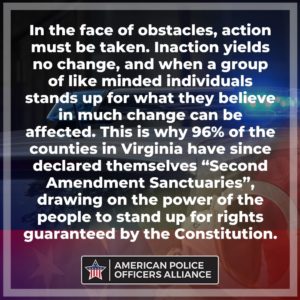It didn’t take long for the freshly elected legislators in Virginia to make their mark on their new territory. After the November 2019 election saw the state hand control back to the Democratic party for the first time in two decades, gun owners apprehensively kept tabs on new initiatives on the horizon. And they had reason to worry.
In February of 2020, the Virginia House of Delegates advanced new gun control measures that would ban sales of some semi-automatic rifles and make extended magazines illegal. These measures, along with the “red flag law” passed in January in the face of staunch opposition, have put the constitutional freedoms of law-abiding American citizens in serious jeopardy — and they aren’t afraid to let this be known.
In the face of obstacles, action must be taken. Inaction yields no change, and when a group of like minded individuals stands up for what they believe in much change can be affected. This is why 96% of the counties in Virginia have since declared themselves “Second Amendment Sanctuaries”, drawing on the power of the people to stand up for rights guaranteed by the Constitution.

The threat to the right to bear arms is heavier with the latest gun control legislation. For example, the newly passed red flag laws allow authorities to confiscate firearms in situations of perceived threat. These threats can be reported by family members or close friends, which means that the individual in question may not have any means of defending themselves against fabricated accusations. While a red flag confiscation certainly could protect some people from harming themselves or others, the gray area these leave cannot be ignored.
The concept of a second amendment sanctuary city has made its way around the country, capturing the interest of gun rights advocates everywhere. The movement continues to make positive progress, with no less than 83 counties declaring as gun sanctuaries in January and 131 declaring as such in December.
The intent of this legislation is to prohibit or impede the enforcement of certain gun control measures, such as red flag laws or universal background checks. The idea is that law-abiding citizens who simply want to have protection should not be punished or criminalized for simply owning or wanting to own a firearm. The ability that these new measures give to third parties to confiscate or otherwise limit firearm ownership and usage is alarming to gun owners. Instead, supporters of sanctuary legislation say, lawmakers should focus more on enforcing existing laws that are intended to target those with criminal intentions or backgrounds.
Much of the support of this movement comes from organizations such as Virginia Citizens Defense League and Gun Owners of America. From drafting legislation to setting up citizen petitions and canvassing for support, much work is needed to help these movements gain traction in a crowded political landscape. But it’s important work that must be done. No one wants to empower a criminal with illicit intentions. However, deterring criminals and allowing for constitutional freedoms should not be grouped into the same category. This is what the new restrictive gun control measures have done.
The very existence of so many gun sanctuary cities should be telling. To date, 31 states have counties with second amendment sanctuary provisions. It’s important to continue to spread education about why second amendment rights are in need of protection, and how criminal activity and personal safety can still be achieved without restricting those rights. Showing our opposition to harmful gun control measures is best done through action.
The tension between sanctuary cities in the U.S. and the federal government has escalated in recent years. Arguments in favor of sanctuary cities include the concept that the removal of fear of deportation allows undocumented immigrants to feel safe reporting crime, leading to statistically lower crime rates in some of these cities. Here’s a closer look at sanctuary cities pros and cons.










